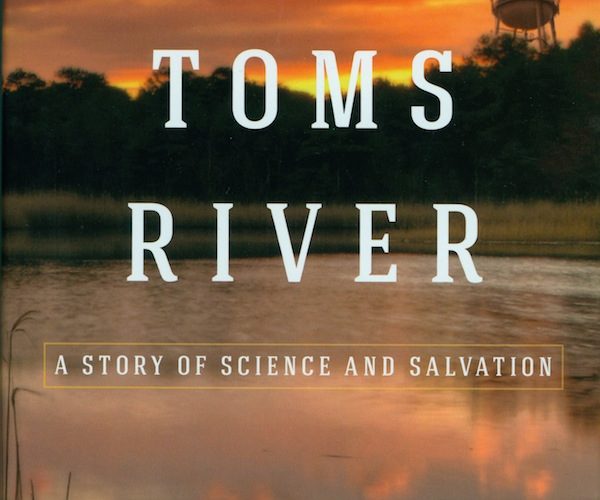IN THE TRADITION OF A Civil Action, The Emperor of All Maladies and The Immortal Life of Henrietta Lacks, Dan Fagin melds hard-hitting investigative reporting with a fascinating scientific detective story and unforgettable characters. At its core, Toms River is a meticulous history of the poisoning of a quaint New Jersey town, but it reads like a crime thriller that is impossible to put down. Sure to become a classic of science reporting, the book also serves as a warning to every community downstream of corporate factories and industrial plants.
Fagin, a prominent American environmental health reporter and a science journalism professor at New York University, paints a painful portrait of Toms River, a community of 90,000 on the Jersey Shore, 80 kilometres east of Philadelphia. It was once a bucolic seaside community with a few claims to fame. The Amityville Horror was filmed here in 1979; in the 1990s, the local baseball team competed in the Little League World Series three times, taking the crown in 1998.
Between that film shoot and that championship, Toms River’s own nightmare was revealed. Although the township includes the Dover Beaches, most of it is inland, surrounded by an array of belching industrial concerns. For Fagin’s narrative, the most important of these was a large chemical plant that loomed mysteriously on the outskirts of town.
The Toms River Chemical Plant arrived in 1952, when its owners, Ciba-Geigy, purchased a parcel of land consisting of about three square kilometres of riverbank pinelands. Following a century of conflict in the company’s native Switzerland, executives “decided to clear 35 acres [14 hectares] right in the middle of the vast property, leaving forested buffers of a half-mile between the buildings and the outside world. For everyone who did not work there, the plant would be out of sight and out of mind.”
That held true until local residents became concerned in the late 1980s and early 90s about the rash of rare cancers plaguing the town’s children. Was it a coincidence or someone’s fault? If the latter, who or what was to blame?
This is where the story gets complicated. Fagin might have simplified, but instead he weaves a panoply of narrative threads and a cast of hundreds with short histories of European dye making, industrial waste management, occupational health and the epidemiology of cancer.
Many suspects were potentially responsible for causing the local disaster. Waste products from the Toms River Chemical Plant were either stored in some 69,000 corroding drums or, later, treated and pumped through a 1.6-km-long pipeline to the Atlantic Ocean. An independent waste hauler cut corners and stored 4,500 waste drums from Union Carbide on a farm above an aquifer that supplied most of the town’s drinking water. When it finally became obvious in the late 1990s that chemicals linked to cancer had contaminated drinking water wells, Toms River Water Company did not treat the water adequately.
Some residents tried to ignore the evidence for fear the revelations would negatively impact tourism. Others worried the chemical plant would shut down, eliminating jobs. Meanwhile, some parents struggled to uncover the mystery that would eventually kill at least 23 children. Against the odds they succeeded, but not before some 90 children were diagnosed with leukemia and rare brain and central nervous system cancers.
The Toms River tragedy was the first time an epidemiological study linked chemical contaminants to a cancer cluster. The sequence of events illustrate what’s wrong with how we assess the risks of industrial activity and, when evidence is apparent everywhere, how we look the other way. You’ll find the usual culprits: greedy corporate executives withholding evidence, self-interested politicians distancing themselves from controversy and lazy government bureaucrats refusing to do their jobs. “The chief legacy of Toms River,” Fagin concludes, “has been to solidify governmental opposition to conducting any more Toms River-style investigations.”
But every epic has its heroes. Linda Gillick stands out, a “normal” mother whose love for her son and community morphs into a ferocious refusal to take no for an answer. There is also a hospital nurse who can’t ignore the parade of young cancer patients and a stubborn government scientist who won’t let the issue die in a filing cabinet.
As evidence mounts that tar sands development in Northern Alberta is polluting groundwater and rivers, and that a cancer cluster may be growing downstream, the takeaway from Toms River is this: a small group of thoughtful and committed citizens is the only way to hold corporations and governments accountable for the injustices they perpetrate.
Toms River: A Story of Science and Salvation, Dan Fagin, New York: Bantam, 2013, 560 pages.
Reviewer Information
Jeff Gailus is an award-winning writer and author of The Grizzly Manifesto and Little Black Lies: Corporate and Political Spin in the Global War for Oil.













